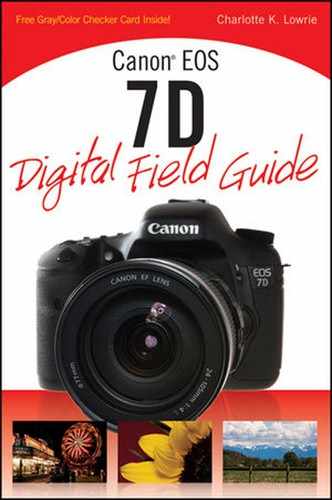If you're reading this introduction in a bookstore as you try to decide which of many books on the Canon EOS 7D to buy, or if you bought the book sight unseen, this is the place to learn what to expect in this Digital Field Guide.
This book assumes that you already own the Canon EOS 7D digital SLR. And if you've used the 7D for any amount of time, then you know that the camera offers superb image quality and speedy performance at 8 frames per second. With the addition of high-resolution 1080i video, the 7D truly becomes a multimedia story-telling tool that opens new doors to creative expression. Under the hood of the 7D, you get the latest iteration of Canon's venerable DIGIC processor with 14-bit processing for smooth tonal gradations, rich color, an expanded ISO range up to 6400 or expanded to 12800, Live View shooting, and loads of handy customization options.
In the Canon DSLR lineup, the 7D provides an ideal segue for serious photographers who want to advance their work — photographers who also expect a full complement of creative controls and high resolution in a light-weight, easy-to-use camera — all of which the 7D offers. For professional photographers, the 7D is a fine second camera body or even primary camera that is versatile enough to shoot even the most demanding assignments.
The challenge for new 7D photographers is putting to use all that the camera has to offer in everyday shooting. That's what this book is designed to do — to be your go-to resource. Here you'll learn not only what the camera features and options are, but also get suggestions on when and how to use them — all without needing to refer back to the camera manual.
You probably have a good sense of the power of the EOS 7D by now, but you may be using only a few of the individual features. This book offers practical suggestions for setting up the camera for specific subjects and scenes so that you use a full set of features in combination. You can use the suggestions as described, or you can use them as jumping-off points for your specific shooting needs. Either way, putting the camera's full power to work for you makes your shooting more efficient so that you can concentrate on the creative work of exploring subjects, lighting, and composition.
Any photography book that you buy should have staying power; in other words, it should be useful to you now and months or years from now. So with that in mind, the book includes both basic and advanced shooting techniques so that both get started quickly and explore the bevy of advanced features as you have time.
You may be wondering if this is the type of book where you can skip around reading chapters that intrigue you in random order. You can, of course, read in any order that you want, but try to read Chapters 1 through 4 early. These chapters provide the foundation for learning the camera, setting up a good workflow, and getting great color. From there you can explore Live View shooting, video, flash, lenses, and specific shooting specialty areas in any order that you want.
Finally, I want to thank the many readers who have contacted me over the years. Your questions, suggestions, and ideas for previous books continue to influence the content of the books that I write today. Thank you, and keep the questions and ideas coming.
The team at Wiley and I hope that you enjoy reading and using this book as much as we enjoyed creating it for you.
Wishing you many beautiful images to come,
Charlotte
